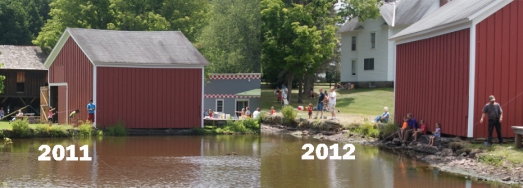Upstate New York has had a significant lack of rain during the past month or so. The ground is dusty, the grass is brown, and water levels in the streams and rivers in the area are remarkably low. Kortright Creek, the body of water that feeds our Mill Pond, is down to a slight trickle and is so dry that there is not enough water to flow into our headrace. We continued to operate our Fitz Overshot waterwheel for as long as we could, but when the thousands of gallons of water that are needed for each demonstration are not replenished there comes a point where the level of the pond is below what is necessary to keep the forebay full, and at that point the waterwheel cannot be used. It’s a situation that we haven’t dealt with to this extent since 1988 and it’s made us consider how the Hanford family would have dealt with a similar situation when they operated the mill.
The photographs above show the difference in water level from July of last year to this year.
First, it is important to realize that while the Museum offers demonstrations of power generation and woodworking machinery that last for short periods, the Hanfords would have been operating machinery all day long and would require a continuous power source. It is also important to remember that the Fitz Overshot waterwheel, one of the highlights of any Hanford Mills Museum tour today, was only installed in 1926 and the Mill has a history that dates back to the mid-1800s. From 1846 to the mid-1880s the mill was powered solely with water, using a combination of wooden waterwheel (for the up and down sash saw) and a turbine (for the gristmill). During this time D.J. Hanford would have operated the Mill mostly during the spring when the runoff from winter snows allowed the pond to be refilled quickly. As spring progressed into summer and the water level became less reliable, D.J.’s focus would turn to his farm, where a drought would be much more destructive than at the Mill. During a drought in June 1895 the Delaware County Dairyman newspaper noted: “Rain is the one thing needful. Pastures are drying up; water is very low; gardens are at a standstill and our well-kept lawns are brown and dying; the hay crop is already past redemption, and unless we get rain soon the result will be empty barns and storehouses…”
From 1895 to the 1930s the use of steam power changed the way the Hanfords operated the Mill and increased the overall importance of it to their business. Once the boiler and engines were installed the Mill could be operated year-round, however this did not mean that waterpower was abandoned. While the records of how steam and waterpower were used in conjunction during this time period are scant at the Mill, it is likely that waterpower was used to supplement, or even in place of, steam power at times when there was ample water flowing into the pond due to its ease of use and relative safety. Waterpower also acted as a reliable backup if the boiler failed or needed repairs, as was the case in April, 1922. The dedication of the Hanfords to waterpower is illustrated by the fact that, even when gas engines and electric power were introduced to the Mill, Will and Horace Hanford felt it appropriate to purchase a Fitz Overshot waterwheel to replace the aging turbines.
While the current drought continues, Hanford Mills Museum is looking back to the days of the Hanford family to understand how to interpret our current situation. We are able to operate much of the historic woodworking machinery through electric power. We recently experimented with using steam power generated by the Mill’s boiler and a restored horizontal engine to power the sawmill. A large belt connects the steam engine to the main shaft in the basement, which transfers power to machines in the Mill. This also causes the Fitz Overshot waterwheel to turn with no water flowing over it, which is an odd sight indeed. Due to the staff and volunteers needed to tend to the boiler and engine whenever it is operating, we will not yet be able to make steam operation a daily part of Museum interpretation, but we will be sure to let everyone know well ahead of time when we plan to operate using our steam plant. In the meantime, let us all wish for a bit of rain to replenish the Mill pond.
The following video shows the main shaft of the belt & pulley system being turned by the Museum’s boiler and restored horizontal steam engine, on July 3rd. If you look closely towards the end of the video, you can see the Fitz Overshot waterwheel in the background, being turned without water.

1 responses to “A Dry Spell at the Mill”
George Hansen
July 20th, 2012 at 02:43
Nice blog post and videos.